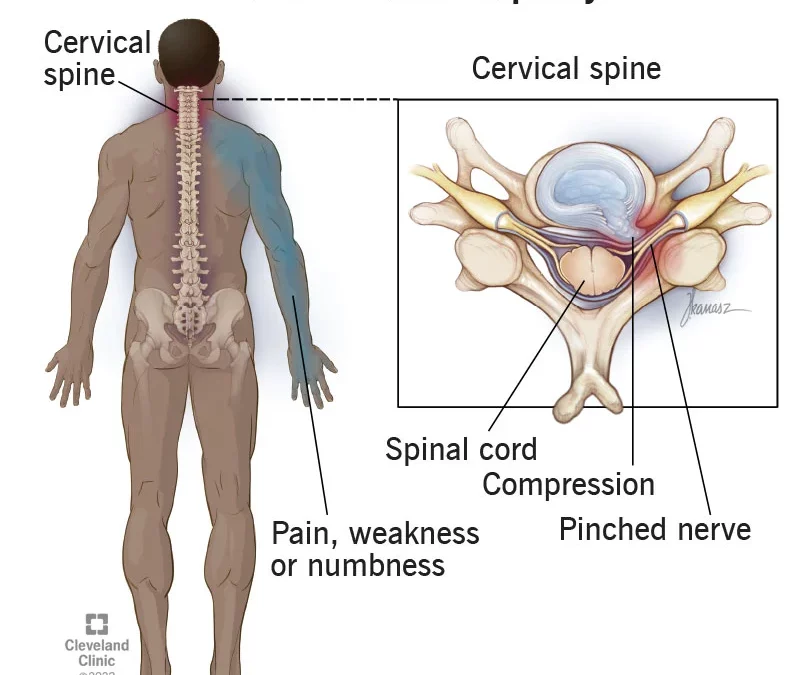“If one chews a problem over long enough, it becomes apparent that the jaw is aching, and what started as weighing heavy on the heart ends up a pain in the neck.” – Anthony Marais
Neck pain can have causes that aren’t due to underlying disease. Examples include prolonged straining (looking up or down), sleeping in an uncomfortable position, stress, or wearing heavy necklaces.Nerve impingement, or “pinched” nerves in the neck region can cause a variety of symptoms and issues. According to the National Institutes of Health (NIH),
“Any condition that causes compression or irritation of a spinal nerve root can result in radicular symptoms. In younger patients, typically in the third and fourth decade, disc trauma and herniation are the most frequent causes of impingement.”
Neck discomfort commonly extends beyond the neck area, radiating towards the shoulders or upper back, occasionally leading to headaches. Prolonged head positioning, such as during computer use, can exacerbate this pain.
Additionally, neck pain often coincides with muscle tightness or spasms, resulting in restricted head movement and decreased flexibility.

Unraveling Cervical Nerve Impingement: How Physical Therapy Can Offer Relief
Cervical nerve impingement, or cervical radiculopathy, often stemming from issues in the neck region, can cause discomfort, pain, and restricted mobility. Physical therapy emerges as a crucial ally in managing and alleviating symptoms associated with cervical nerve impingement.
It is essential for those suffering from neck pain to understand what cervical nerve impingement entails, its symptoms, and how physical therapy serves as an effective avenue for relief and rehabilitation.

Understanding Cervical Nerve Impingement
Cervical nerve impingement occurs when nerves in the neck region, particularly the cervical spine (C1-C7), become compressed or irritated due to various factors.
Common causes include herniated discs, degenerative changes, bone spurs, or spinal stenosis, leading to pressure on the nerves and resulting in pain, tingling, numbness, or weakness in the neck, shoulders, arms, or hands.
Symptoms and Their Impact:
How Physical Therapy Addresses Cervical Nerve Impingement
Comprehensive Assessment: Physical therapists conduct an in-depth evaluation encompassing various aspects related to cervical nerve impingement. This assessment involves analyzing the patient’s medical history, conducting physical examinations, assessing nerve function, and identifying specific areas of nerve compression or irritation.
Specialized tests, such as range of motion assessments, muscle strength evaluations, and neurological examinations, aid in determining the severity and precise location of impingement.
Individualized Treatment Plans: Based on the assessment findings, physical therapists develop personalized treatment plans tailored to address the patient’s unique condition and needs. These plans consider the severity of impingement, the patient’s goals, and any underlying factors contributing to the issue.
Manual Therapy Techniques: Hands-on manual therapy techniques form a cornerstone of cervical nerve impingement treatment. Therapists use various approaches, including joint mobilization, myofascial release, and gentle traction, to alleviate pressure on the affected nerves and surrounding structures. These techniques aim to improve joint mobility, reduce muscle tension, and restore proper alignment in the cervical spine.
Therapeutic Exercises: Specific exercises targeting strength, flexibility, and posture are prescribed to address the underlying causes of nerve impingement. These exercises focus on strengthening supportive muscles, improving posture, and enhancing the stability of the cervical spine. Stretching exercises aim to increase flexibility and reduce stiffness, aiding in alleviating nerve compression.
Modalities and Pain Management: Physical therapists employ various modalities to manage pain and inflammation associated with cervical nerve impingement. These modalities include ultrasound, electrical stimulation, heat, or cold therapy. By reducing pain and inflammation, these modalities facilitate a more conducive environment for healing and rehabilitation.
Education and Self-Care Strategies: Patient education is a vital component of cervical nerve impingement treatment. Therapists educate patients about proper posture, ergonomics, and lifestyle modifications to avoid exacerbating symptoms.
Patients are guided on self-care strategies, such as home exercises, ergonomic adjustments in daily activities, and techniques to manage discomfort between therapy sessions. Empowering patients with knowledge and self-management skills is crucial for long-term relief and prevention of recurrence.
These multifaceted approaches within physical therapy for cervical nerve impingement are tailored to address the specific symptoms, underlying causes, and individual needs of each patient, aiming for comprehensive rehabilitation and improved quality of life.
Four Benefits of Physical Therapy for Cervical Nerve Impingement
Keep in mind that the goal and purpose of any physical therapy treatment is to help people improve their mobility, regain function, manage pain, and prevent or recover from injuries or physical conditions.
While physical therapy is not, in itself, a “cure” for the conditions being treated, there are several benefits that can be gained with effective treatment through physical therapy:
Nerve Impingement Neck Pain – Finding Total Relief
Cervical nerve impingement can significantly impact one’s quality of life, but physical therapy emerges as a non-invasive and effective means of managing its symptoms. Through a multifaceted approach encompassing manual techniques, targeted exercises, and patient education, physical therapists work to alleviate pain, restore mobility, and enhance functionality for individuals dealing with cervical nerve impingement.
Seeking early intervention and adhering to a comprehensive physical therapy program can pave the way towards alleviating discomfort and promoting a healthier, pain-free lifestyle for those affected by this condition.
Effective Solutions from Pain and Performance
If you’re suffering from chronic neck pain, or the pain of pinched cervical nerves, we invite you to start your journey towards total pain relief.
One of many approaches we offer is the Active Release Technique®, or ART®, which is a proven method for addressing a diverse range of soft tissue and joint pain. ART® is a patented, non-invasive treatment approach tailored to target various types of soft tissues.
This treatment, as with all of our therapies, is both secure and free of pharmaceuticals, while being remarkably efficient.
Contact us for an appointment today.
During our preliminary consultation and evaluation, we will work with you to establish a comprehensive understanding of your existing pain issues, your history concerning neck pain and discomfort, any distress you may have encountered, and your current physical activity level.
Call us today at (707) 636-4404 or make use of our online booking form to schedule a consultation and pay a visit to our office.

